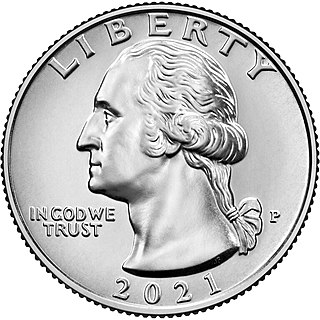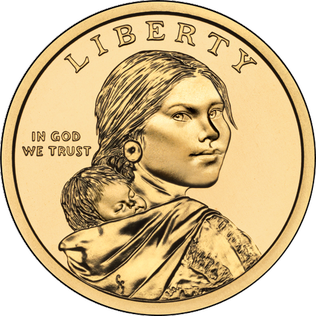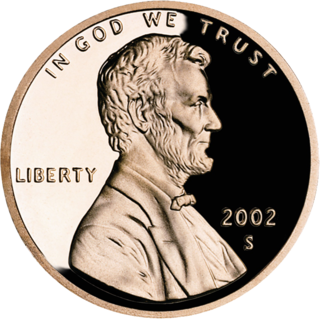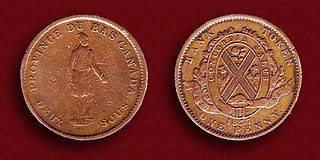
The quarter, short for quarter dollar, is a United States coin worth 25 cents, one-quarter of a dollar. It has a diameter of 0.955 inch (24.26 mm) and a thickness of 0.069 inch (1.75 mm). The coin sports the profile of George Washington on its obverse, and its reverse design has changed frequently. It has been produced on and off since 1796 and consistently since 1831.
Coins of the United States dollar were first minted in 1792. New coins have been produced annually and they make up a valuable aspect of the United States currency system. Today, circulating coins exist in denominations of 1¢, 5¢, 10¢, 25¢, 50¢, and $1.00. Also minted are bullion and commemorative coins. All of these are produced by the United States Mint. The coins are then sold to Federal Reserve Banks which in turn are responsible for putting coins into circulation and withdrawing them as demanded by the country's economy.
Seigniorage, also spelled seignorage or seigneurage, is the difference between the value of money and the cost to produce and distribute it. The term can be applied in two ways:

The Canadian dollar is the currency of Canada. It is abbreviated with the dollar sign $, or sometimes CA$, Can$ or C$ to distinguish it from other dollar-denominated currencies. It is divided into 100 cents (¢).

The United States one-cent coin, often called the "penny", is a unit of currency equaling one one-hundredth of a United States dollar. It has been the lowest face-value physical unit of U.S. currency since the abolition of the half-cent in 1857. The first U.S. cent was produced in 1787, and the cent has been issued primarily as a copper or copper-plated coin throughout its history. Its obverse has featured the profile of President Abraham Lincoln since 1909, the centennial of his birth. From 1959 to 2008, the reverse featured the Lincoln Memorial. Four different reverse designs in 2009 honored Lincoln's 200th birthday and a new, "permanent" reverse – the Union Shield – was introduced in 2010. The coin is 0.75 inches (19.05 mm) in diameter and 0.0598 inches (1.52 mm) in thickness. Its weight has varied, depending upon the composition of metals used in its production.

The pound sterling, known in some contexts simply as the pound or sterling, is the official currency of the United Kingdom, Jersey, Guernsey, the Isle of Man, Gibraltar, South Georgia and the South Sandwich Islands, the British Antarctic Territory, and Tristan da Cunha. It is subdivided into 100 pence. The "pound sterling" is the oldest currency in continuous use. Some nations that do not use sterling also have currencies called the pound.

The dollar coin is a United States coin with a face value of one United States dollar. It is the second largest U.S. coin currently minted for circulation in terms of physical size, with a diameter of 1.043 inches and a thickness of 0.079 in (2.0 mm), coming second to the half dollar. Dollar coins have been minted in the United States in gold, silver, and base metal versions. Dollar coins were first minted in the United States in 1794.

The 50 State quarters was a series of circulating commemorative quarters released by the United States Mint. Minted from 1999 through 2008, they featured unique designs for each of the 50 US states on the reverse.

The United States one-dollar bill ($1) since 1876 has been the lowest value denomination of United States paper currency. An image of the first U.S. president (1789–1797), George Washington, based on the Athenaeum Portrait, a 1796 painting by Gilbert Stuart, is currently featured on the obverse, and the Great Seal of the United States is featured on the reverse. The one-dollar bill has the oldest overall design of all U.S. currency currently being produced. The obverse design of the dollar bill seen today debuted in 1963 when it was first issued as a Federal Reserve Note.
University RAGs are student-run charitable fundraising organisations that are widespread in the United Kingdom and Ireland. Some are run as student societies whilst others sit with campaigns within their student unions. Most universities in the UK and Ireland, as well as some in the Netherlands and the Commonwealth countries of South Africa and Singapore have a Rag. In some universities Rags are known as Charities Campaigns, Charity Appeals, Charity Committees, Jool or Karnivals, but they all share many attributes.
The Jamaican dollar has been the currency of Jamaica since 1969. It is often abbreviated to J$, the J serving to distinguish it from other dollar-denominated currencies. It is divided into 100 cents, although cent denominations are no longer in use as of 2018. Goods and services may still be priced in cents, but cash transactions are now rounded to the nearest dollar.

In Canada, a penny is a coin worth one cent, or 1⁄100 of a dollar. According to the Royal Canadian Mint, the official national term for the coin is the "one-cent piece", but in practice the terms penny and cent predominate. Penny was likely readily adopted because the previous coinage in Canada was the British monetary system, where Canada used British pounds, shillings, and pence as coinage alongside U.S. decimal coins and Spanish milled dollars.

Counterfeit money is currency produced without the legal sanction of the State or government, usually in a deliberate attempt to imitate that currency and so as to deceive its recipient. Producing or using counterfeit money is a form of fraud or forgery, and is illegal. The business of counterfeiting money is almost as old as money itself: plated copies have been found of Lydian coins, which are thought to be among the first Western coins. Before the introduction of paper money, the most prevalent method of counterfeiting involved mixing base metals with pure gold or silver. Another form of counterfeiting is the production of documents by legitimate printers in response to fraudulent instructions. During World War II, the Nazis forged British pounds and American dollars. Today some of the finest counterfeit banknotes are called Superdollars because of their high quality and imitation of the real US dollar. There has been significant counterfeiting of Euro banknotes and coins since the launch of the currency in 2002, but considerably less than that of the US dollar.

A debate exists within the United States government and American society at large over whether the one-cent coin, the penny, should be eliminated as a unit of currency in the United States. The penny costs more to produce than the one cent it is worth, meaning the seigniorage is negative – the government loses money on every penny that is created. Several bills introduced in the U.S. Congress would have ceased production of pennies, but none have been approved. Such bills would leave the five-cent coin, or nickel, as the lowest-value coin minted in the United States.

Coin roll hunting is the hobby of searching and sorting coinage pulled from circulation for collectible coins. This is achieved through obtaining rolled coin, boxed coin, or bagged coin from banks and credit unions. A variant of this practice involves banknotes and is carried out in essentially the same fashion, normally to search for unusual serial numbers, star notes and misprints.

Quentin David Bowers is an American numismatist, author, and columnist. Beginning in 1952, Bowers’s contributions to numismatics have continued uninterrupted and unabated to the present day. He has been involved in the selling of rare coins since 1953 when he was a teenager.

The United States dollar is the official currency of the United States and its territories. The Coinage Act of 1792 introduced the U.S. dollar at par with the Spanish silver dollar, divided it into 100 cents, and authorized the minting of coins denominated in dollars and cents. U.S. banknotes are issued in the form of Federal Reserve Notes, popularly called greenbacks due to their historically predominantly green color.
Slang terms for money often derive from the appearance and features of banknotes or coins, their values, historical associations or the units of currency concerned. Within a language community, some of the slang terms vary in social, ethnic, economic, and geographic strata but others have become the dominant way of referring to the currency and are regarded as mainstream, acceptable language.

The United States two-dollar bill ($2) is a current denomination of United States currency. A portrait of Thomas Jefferson, the third president of the United States (1801–1809), is featured on the obverse of the note. The reverse features an engraving of the c. 1818 painting Declaration of Independence by John Trumbull.

The Habitant token were a series of tokens that were created for use primarily within Lower Canada and were issued in 1837. Produced as a successor to the popular bouquet sous, these tokens depicted a Habitant on the obverse, a traditional depiction of a French-Canadian farmer in winter clothing, and the coat of arms for the City of Montreal on the reverse. The tokens were issued in both one penny/deux sous and half penny/un sou denominations by the leading commercial banks of Montreal. They were issued in large numbers and can be easily acquired by the modern collector, though some varieties are rare and command a premium.















